

![]()
MAKING A FOLDING
|
By F. E. Hutt. |
|
As an editing rack, the unit is rigidly supported alongside the viewer and splicer. It holds and stores 60 strips of 16mm film or 100 strips of 8mm. |
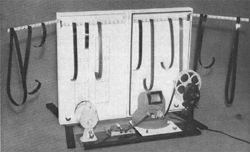 |
IN ADDITION TO SIMPLIFYING the mechanics of editing, making this 60-shot folding editing rack actually shows a considerable profit. It is also an indexed film storage cabinet which will save several pounds in the cost of reel cans.
When used as an editing rack, it stands rigidly alongside the viewer and splicer. The film strips hang on numbered pins and any shot is instantly identified by its number. All shots are immediately to hand for viewing and assembly. A decided advantage over most editing racks is that it can be folded and closed with all the strips of film left in place. This is useful when editing cannot be finished in one session - the film strips are stored in a dust proof container and they are left in exactly the same order ready for the next session.
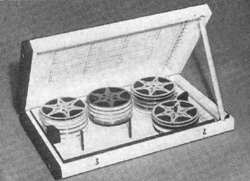 |
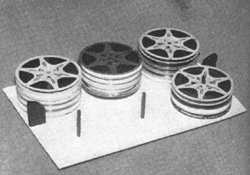 |
As a film storage cabinet, it will hold up to thirty-six 200ft 8mm reels, but limiting to twenty-four makes selection easier. It is easily modified for other spool sizes or gauges. |
All the films lift out en bloc. Any title is easily selected and then instantly found from the enclosed index. |
When used as a film storage cabinet, its enclosed index enables you to first select, and then instantly find any particular film. When putting on a show, all the films from which your programme is to be chosen will be there in the one container alongside the projector. It holds twenty-four 200ft 8mm. films - but the size may be modified to hold more, or larger spools of any gauge.
It is easily made from hardboard and standard size stripwood at negligible cost. The suggested size of 20 x 12in. is convenient for storage and holds strips of film up to 18in. long or double this length when looped. This corresponds to 8mm silent shots up to 7½ and 15 seconds or half these times with 16mm. Longer shots are not often needed but by using more than one loop on the pivoted film hangers, shots or sequences of any duration may be hung and stored. If only intended for 8mm, closer spacing may be used to give an increased capacity of up to a hundred strips.
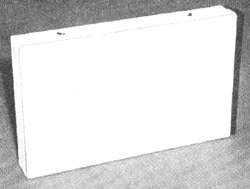 |
It is completely dust-proof, and is a convenient shape for easy storage. |
Assuming this size is convenient, cut two pieces of hardboard 19 x 12in. and then nail strips of 1½ x ½in. wood to the sides as shown in the drawing. Of the two resulting shallow boxes one needs to be about 1/16in. smaller than the other. It is unlikely that you will have made both boxes spot on size, so select the larger of the two for the lid.
Use the smaller one for the bottom and cut strips of hardboard to fit inside and so make a flange projecting about Jin. above the sides. This flange makes a dust seal when the two boxes are hinged together as a single box to form the storage container.
The open box is supported vertically on its end by two pivoted struts, bolted to the bottom of each half by a 2 x ¼in. bolt and wing nut. Normally the struts are flush with the end of the box, but open out when needed. Wing nuts lock them in both positions.
Cut the struts from 1½ x ½in. wood making the top member of each pair 12in long. Nail a 1½ x 1½ x ½in. piece of woo one end of each top member to form a balancing foot. By cutting the lower member, 10½in. long they will open out on the same plane as the top ones, but nest inside when closed.
Two of the four ½in. dowel film hangers are fixed. One is fitted, touching the bottom and sides, to each half box and positioned an inch from the ends. The other two are about an inch shorter and are pivoted, one each from the outer side of each half box. Fit the hinges for these two at a position to allow the hangers to be flush with the top of the box sides when closed, and spaced one inch away from the fixed hangers. Cut ½in slots in the box sides if the pivoted arms are required to open a full 180 degrees.
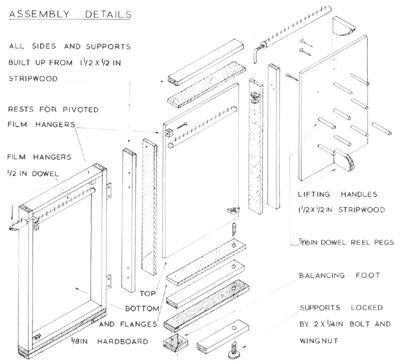 Starting from the left, drive No. 19 gauge
panel pins into the four hangers every ¾in.
and number them from 1 to 60. Super 8 will
require thinner pins. If these are not
available use ordinary dressmaking pins.
Cut a small nick in a ¼in. thick piece of
wood and use this as a gauge to cut all the
pins to the same length.
Starting from the left, drive No. 19 gauge
panel pins into the four hangers every ¾in.
and number them from 1 to 60. Super 8 will
require thinner pins. If these are not
available use ordinary dressmaking pins.
Cut a small nick in a ¼in. thick piece of
wood and use this as a gauge to cut all the
pins to the same length.
In order to pivot the outer hangers, cut the heads off two 3in. x No. 10 wood screws and bend the plain shank at right angles to the thread. Fix a bent screw in the end of each hanger - but first drill the wood as it may split. The hinges themselves are simply U-shaped brackets drilled 3 in. Screw a ¾ x ½ x ½in. piece of wood to the inside of the box opposite each hinge and so provide a rest for each pivoted hanger when in the closed position.
The spool holder is simply a 16 x I1in. piece of hardboard having six evenly spaced 2¾ x 5/16in. dowel pegs. These are fixed from underneath with ½ in x No. 4 screws. Fix a 2 x 1½ x ½ in handle at each end and the holder, loaded with films, can then be easily lifted out of the cabinet.
To complete, fit two fastening hooks for closing, seal the surfaces of the hardboard and then paint the insides white for maximum reflection. Write out the film index on plain paper and tape or glue it to the lid.
There is plenty of room in the unit to store all the film strips without buckling or damage, and there will be no difficulty experienced when closing the unit in the vertical position. To close in a horizontal position, a thin piece of card, held by two turn buttons, would be required in the lid. This would fit over the strips and hold them in place while the lid is lifted over for closing.
About the only valid objection to its use as a film storage cabinet is that there is no protection for the stored films while editing is taking place. This snag is mostly eliminated by obtaining a large polythene bag which will hold the spool holder and films during the comparatively short editing period.
![]()
This page was last updated 02 Dec 2002